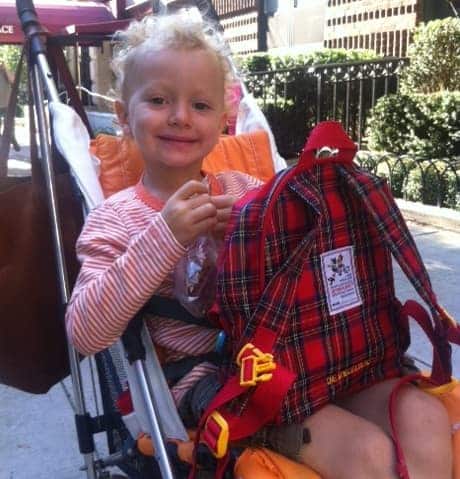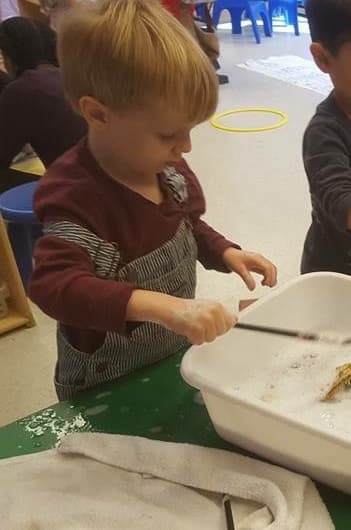
Written by Maia, President & Founder
Over the last few years, there has been much attention drawn to this idea of “grit” as being a more important predictor of success than brains. I recently sat down with Inna Thomka, a licensed social worker with a decade of experience working with a diverse population, to discuss why grit, which she refers to as “resilience,” matters so much and how we can foster it in our children.
Maia James: What is resilience, generally speaking?
Inna Thomka: Resilience is the ability to successfully overcome serious hardship by bouncing back from tragedy, trauma, risks, and stress. It can be broadly understood as capacities for persistence, creativity, emotional intelligence, grit, cognitive flexibility, risk-taking, adapting to change, delaying gratification, learning from failure, and questioning success.
MJ: We keep hearing about how important “grit” is in kids, and I think as parents we all worry that our own kids aren’t gritty enough! Why is it important to understand resilience in children?
IT: Understanding why some children do well despite adverse early experiences, while others do not, is crucial because it can make us better parents, caregivers, and educators to children who have experienced traumatic life events and other hardships. It can also inform more effective policies and programs that help children reach their full potential.
MJ: What is the single most common protective factor for children who develop resilience?
IT: At least one stable and committed relationship with supportive parent, caregiver, or other adult. These relationships provide the personalized protection that buffer children from developmental disruption. They also build key skills- such as the ability to plan, monitor, and regulate behaviors- that enable children to respond adaptively to adversity and thrive.
MJ: How can we understand resilience in children who have NOT undergone trauma or unusual hardship? In other words, why is this important even just for the average child?
IT: It’s important to understand how to develop a resilient mind-set in children, even if they have not undergone what most of us consider “traumatic or unusual hardships” (i.e. abuse, neglect, or lack of basic necessities). Every child experiences challenging situations and disappointments on a daily basis! Children process, internalize, and react to those experiences differently. Some children are more sensitive than others to daily stressors (i.e. saying goodbye to a parent in the morning or feeling left out during play time) and may even find them to be traumatizing.
Therefore, even a child that has not undergone trauma or excessive stress needs to build resilience. Children who do not have the supports around them to help cultivate this skill may have a more difficult time coping with everyday challenges such as changes in routine, peer conflict, treating oneself and others with respect, and problem-solving.
So, if we as parents/caregivers/teachers have an understanding of what resilience is and how we can assist in nurturing the type of environment that supports its development, then children will likely have an easier time coping with stressors, bouncing back from disappointments, and gaining more insight into navigating the world around them in healthy and appropriate ways.
 MJ: I have a kid who definitely seemed traumatized from the simple act of saying goodbye to me each morning at preschool. So, can you give some concrete examples of how we might foster increased resilience in your average 3-year-old? To again use this example of separation from a parent: does a “ripping off of the bandaid” approach work here, or would you recommend a gentler approach? Which is more likely to build resiliency?
MJ: I have a kid who definitely seemed traumatized from the simple act of saying goodbye to me each morning at preschool. So, can you give some concrete examples of how we might foster increased resilience in your average 3-year-old? To again use this example of separation from a parent: does a “ripping off of the bandaid” approach work here, or would you recommend a gentler approach? Which is more likely to build resiliency?
IT: The goal in fostering resilience in a person (young or old), is to provide him/her with a set of tools that are quick, easy, and simple to use and are proven to help the person feel better faster. Experts have identified 4 Basic Characteristics of Building Resiliency (Henderson, et al., 1999).
- Resilient attitude: “You have what it takes”
- Focus on strengths not weaknesses
- Provide caring, supportive environment
- Give it time
Let’s apply an everyday example and see how we can utilize these four characteristics to build resilience in a 3-year-old, who is in a new school setting and is having difficulty separating from parent at drop-off.
- Resilient Attitude: “You Have What It Takes”
Discuss the situation with your child in a “safe” place when they are calm and happy (not at drop-off time). Actively listen to their fears and validate their feelings, and instead of dismissing them and adopting a “ripping off the bandaid approach” by saying something like, “You need you to be better at drop-off” or “You’ll be fine, it’s no big deal” (because most likely it is a huge deal to them), instead say something like, “You are so strong, I know it is so difficult to start a new school, when you don’t know anyone, but you are very tough and I know you can do it.”Another way to build them up is to remind your child of a time they have overcome a similar challenge and connect it to the challenge at hand, for instance, you can say, “Hey bud, remember when you went to a birthday party an you did not know anyone, but then you made friends with all these new kids and had a great time etc., this is just like that.”
- Focus on Strengths, Not Weaknesses
Highlight your child’s strengths as they relate to being able to adjust to the new environment. For instance, instead of saying something like, “I can’t believe you are still acting like this, you are 3 years old now, you should not be crying at drop-off!” utilize their strengths and provide opportunities for meaningful participation: “You are such a great helper, I know the teacher needs help in the morning, do you think that you could help set-up for breakfast?” Of course, discuss your plan with the teacher, so everyone is on the same page. - Provide Caring/Supportive Environment
Talk to the teachers beforehand and ensure that they are caring and empathetic and are on the same page with your approach to the issue. For example, instead of the teacher giving a directive right away, such as “Time to let go of your mother now, please go sit down at the table,” ensure that he/she validates your child’s feelings, acknowledging their fears and lets them know they are there to help and support them. Teachers may want to say something like, “I am here for you and I will help you, it is so hard to be away from your mom, and it is ok to cry,” or “Would you like to help me take out books for circle time?” - Give it Time (Set Clear and Consistent Boundaries; Be Consistent)
Allow the child to take their time to adjust to their new environment, and try not to impose your own timeline. Also, it may help to set clear and consistent boundaries at drop off, for instance, instead of staying with a child in their classroom for a different amount of time, depending on their behavior at drop off, set clear expectations beforehand. For example, in a “safe” environment (not at drop off), inform them that mommy will have to leave, when he/she sits down for breakfast, and be consistent. This way the child knows what to expect. Discuss your plan with the teacher, so everyone is on the same page.
MJ: What is the biggest misconception regrading resilience in children?
IT: That children are either born with resilience or they are not. In reality, resilience is something that is developed over time. Research suggests that human beings are born with innate self-righting ability, which can be helped or hindered. The capabilities that underline resilience can be strengthened at any age. The brain and other biological systems are most adaptable early in life, but it is never too late to build resilience.
MJ: Wow, this is so helpful. Can you recommend resources for parents to learn more about this?
IT: Yes, here are some of my favorite websites:
- http://www.resiliency.com
- http://www.bouncebackproject.org/resilience/
- http://www.search-institute.org/
And here’s some great Literature on Resilience for Children:
- 101 Mindful Ways to Build Resilience, Cultivate Calm, Clarity, Optimism & Happiness Each Day, by Donald Altman
- The Hugging Tree, A Story About Resilience, by Jill Neimark
- Bounce Back, How to Be a Resilient Kid, by Wendy L. Moss, PhD
- Bella Eve, The Bounce Back Dog, A Puppy’s Journey of Resiliency, by Kasey Crawford Kellem
- Have You Filled a Bucket Today, A Guide to Daily Happiness for Kid’s by Carol McCloud
- But Aren’t I Lucky That…by Deanna Beech
 Inna Katsev Thomka is a Licensed Clinical Social Worker (LCSW), and mother of two. Over the course of the last decade, Inna has worked in a variety of community-based, mental health programs, as well as residential facilities and acute care settings and have provided individual, group, and family counseling, as well as case management and crisis intervention services to children, adolescents, and adults of diverse ethnic and socio-economic backgrounds.
Inna Katsev Thomka is a Licensed Clinical Social Worker (LCSW), and mother of two. Over the course of the last decade, Inna has worked in a variety of community-based, mental health programs, as well as residential facilities and acute care settings and have provided individual, group, and family counseling, as well as case management and crisis intervention services to children, adolescents, and adults of diverse ethnic and socio-economic backgrounds.
Stay sane,
If you liked this post, sign up for our newsletter to be alerted when we publish new content like this!









Dina Igoe says
Love this, Inna! Very helpful tips and specific advice as I have an upcoming kindergartner starting a new school and I’m sure there will be anxiety associated with it. She also is afraid of flying bc she remembers her ears hurting, so I will be putting some of these tips to use ASAP.